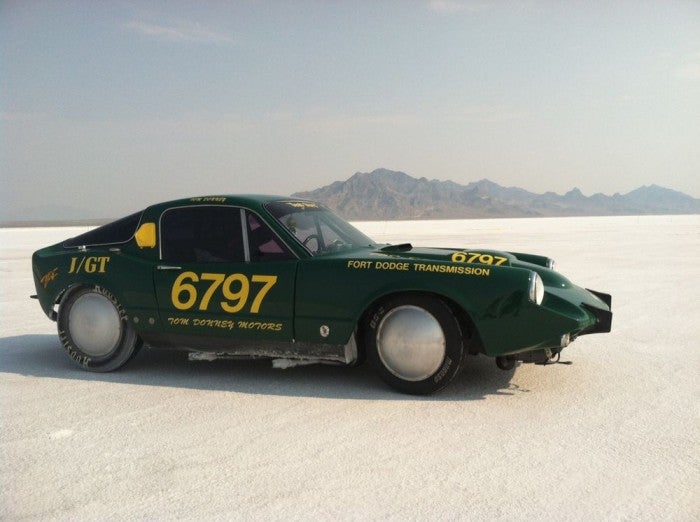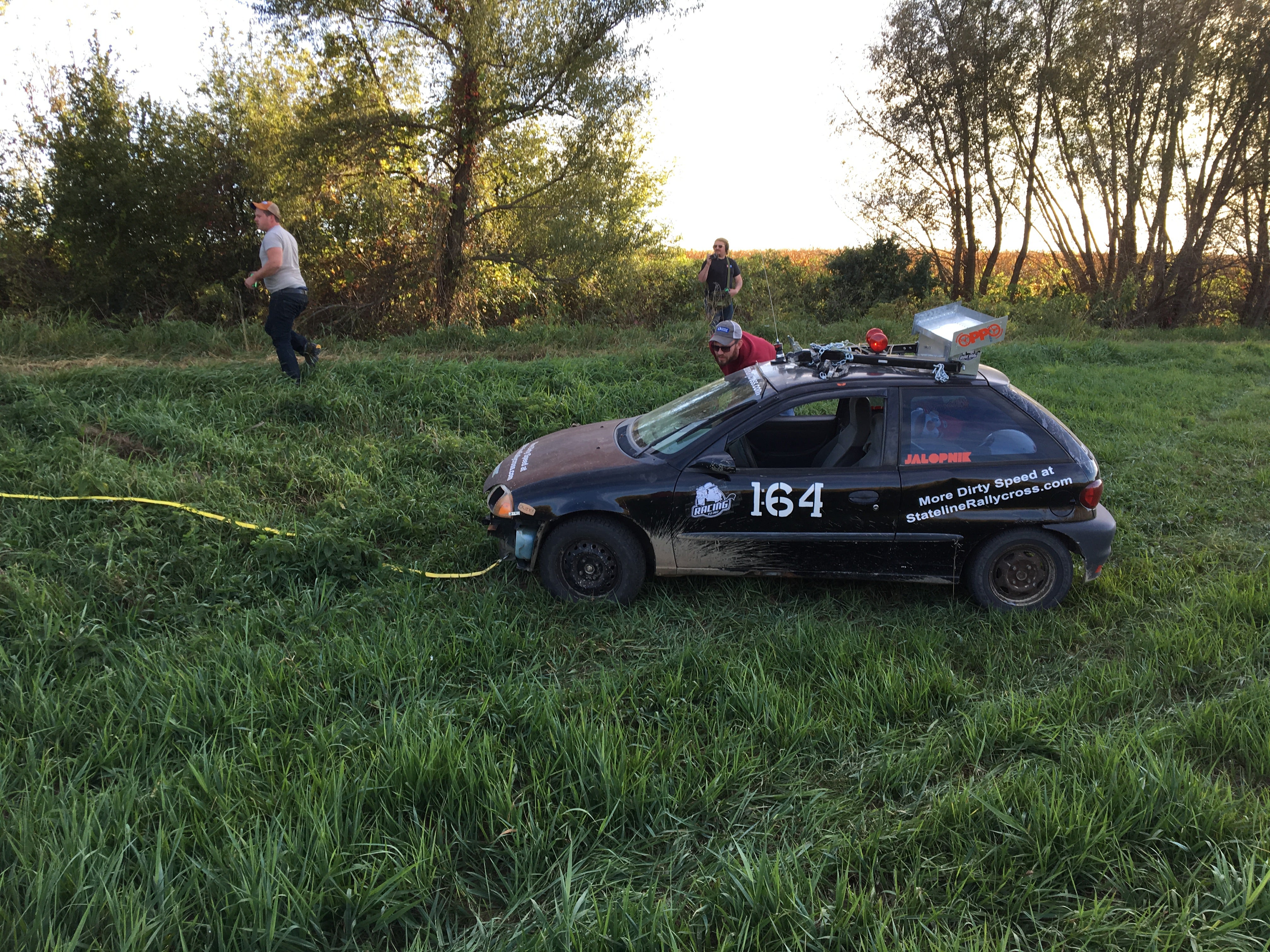 by "Grindintosecond" (Grindintosecond)
by "Grindintosecond" (Grindintosecond)
Published 10/10/2017 at 20:35
 by "Grindintosecond" (Grindintosecond)
by "Grindintosecond" (Grindintosecond)
Published 10/10/2017 at 20:35
No Tags
STARS: 4

This SAAB 97 (Sonnnet III) is slicker than that crazy small first Honda Insight hybrid. The 1970-74 model year is .01 Cd slicker.
Not because of the Bonneville Moon hubcaps, oh no. STOCK it was a slick car to begin with. In fact, when I finally set aside money piles to set on fire, It will be a tough decision to pick this car over something else because it doesn’t really look like it should be that slippery. Why? Well because math and you now have to read over some math...
Everyone here has heard at about a car’s coefficient of drag. Yes. It measures aerodynamic efficiency. But what else measures how slippery a car is? Have you also read over Frontal Area? That figures into the formula of total aerodynamic drag like this:
Cd * A = a number that demonstrates total overall snotty slippery property. Or, CdA.
In this case, whereas the Sonnet III has a Cd of .31 and a Honda Insight compares with a Cd of .25, the fronntal area of both makes the difference. The Sonnett has less frontal area and when multiplied together, comes out with .6% less total CdA than the 2000-2006 Insight.
SAAB 97 (Cd .31 * A 15.15 = 4.70 CdA)
Insight (Cd .25 * A 20.00 = 5.00 CdA)
So we can see here, that should I take a trip to bonneville, I will do it in most likely a 1970-1974 SAAB 97 Sonett with swappable BMW rr1000 literbike and Suzuki GXR-750 motors.
Compared to one of the worst aerodynamic barn doors? Merceded Benz G class: CdA 16.8. RAM 1500 is even worse.
database used to compile results.
 "If only EssExTee could be so grossly incandescent" (essextee)
"If only EssExTee could be so grossly incandescent" (essextee)
10/10/2017 at 20:44, STARS: 1
My 0.27 Cd gives the Insight a run for its money but the the sheer size of my car gives me a CdA of 6.3
 "Daily Drives a Dragon - One Last Lap" (ddadragon)
"Daily Drives a Dragon - One Last Lap" (ddadragon)
10/10/2017 at 21:19, STARS: 1
Well.... I was going to see how the 4Runner stacked up to the G wagon but it’s not on the list which to me implies don’t even try.
 "shop-teacher" (shop-teacher)
"shop-teacher" (shop-teacher)
10/10/2017 at 21:53, STARS: 1
So you’re saying don’t take the RallyMetro equipped with StupidWing to Bonneville?

 "Grindintosecond" (Grindintosecond)
"Grindintosecond" (Grindintosecond)
10/10/2017 at 22:12, STARS: 0
All depends on what engine class you bring to the party. Your AA over 8 liter blown fuel category 4Runner could take down the g wagon.
 "Grindintosecond" (Grindintosecond)
"Grindintosecond" (Grindintosecond)
10/10/2017 at 22:13, STARS: 2
Strip the wing. There’s a metro out there in a category running a 1.3 engine.
 "Daily Drives a Dragon - One Last Lap" (ddadragon)
"Daily Drives a Dragon - One Last Lap" (ddadragon)
10/10/2017 at 22:17, STARS: 1
I was saying in terms of aero as it still has the 5VZ and that won’t change.
 "Rock Bottom" (rockbottom81)
"Rock Bottom" (rockbottom81)
10/10/2017 at 22:27, STARS: 1
Ok, as an automotive aerodynamicist I feel it critical to ask a couple questions here:
1) How was the Sonnet Cd tested and confirmed? I ask because (to my admittedly limited knowledge) the only wind tunnel capable of testing a full-scale car in 1970-1974 was Lockheed in Georgia, and their tunnel disagrees (just a bit) with everyone else’s. At least before the most recent circuit overhaul a few years ago. To be clear, this is a very normal tunnel-to-tunnel delta, their tunnel is actually very good. I would bet Saab’s claimed Cd was determined by scale model testing, as was the industry norm well into the early 2000s. This means it was
probably
measured on a simplified scale model, likely without taking cooling flow and accurate underbody flow into consideration. Those errors together can lead to as much as 20% to 30% error, which was fine back in the day because it was consistent with how everyone else was measuring drag.
2) Which method was used to determine the Honda Cd? Factory claimed? Because according to my own testing, Honda self-reports Cd values about 11% lower than the average benchmarked values measured by “the rest of us”. They don’t “lie” as much as the Germans sometimes do (looking at you, Mercedes and Audi), but they’re still pretty optimistic in their published brochure data.
Now this leads us to an important point that the aerospace industry learned in the 1950s, and the auto industry is in some ways just acknowledging now: To compare aero drag and lift, you need to test at the same scale, with the same type of test article, and in the same tunnel. Otherwise, you’re comparing apples and bananas.
You’ll find that most aerospace companies will always return to one particular tunnel with one particular model to make running changes. That is an effort to control the experiments as much as possible over the life of an airframe design, which can be decades. Changing “venues” will always introduce error. Hell, those guys will even go so far as to use the exact same internal balance every time! The auto industry is getting to a similar place today. All of the sign-off testing for a particular car company will generally be performed in one specific tunnel. Sure, some correlation work is done between tunnels, but every effort is generally made to keep it in one place because of the potential for unknown deltas between tunnels. This is why it’s damn hard to both accept manufacturer’s self-reported Cd values, and to compare Cd values across different manufacturers unless the data are all gathered in the same facility by the same people. Of course, there are certain exceptions to the “all in one tunnel” rule. WIndShear in North Carolina, FKFS in Germany, Pininfarina in Italy, Tongji in China, and Volvo in Sweden are all used by various automakers, but usually only for specific development work and targeted science projects. The final published number will almost always come out of the dedicated in-house tunnel.
And no, you can’t use CFD to report a Cd unless you verify it in a tunnel. We’re still several decades away from that.
 "Grindintosecond" (Grindintosecond)
"Grindintosecond" (Grindintosecond)
10/11/2017 at 00:36, STARS: 1
Thank you for the insights. I suppose my article post was about how a low Cd means little without a frontal area to put to it, and how some cars could surprise us with their overall package.
 "Rock Bottom" (rockbottom81)
"Rock Bottom" (rockbottom81)
10/11/2017 at 07:45, STARS: 0
Yeah, full disclosure: I was drunk when I responded last night. Sorry it came out a little spicy! But you are absolutely correct in that almost everyone talks about Cd but nobody considers the other side of the coin! I’ve been saying for years that the industry should report aero horsepower at like 70 mph, but that’s way too logical to work!
 "Discerning" (discerning2003c5z)
"Discerning" (discerning2003c5z)
10/11/2017 at 08:04, STARS: 0
While drag area is often ignored in favor of just drag coefficient, it’s worth noting that someone picking a car should consider more than just drag area. Lift and stability are huge factors that can quickly ruin your day if not considered when you plan on taking your car to terminal speed.
 "Grindintosecond" (Grindintosecond)
"Grindintosecond" (Grindintosecond)
10/11/2017 at 09:45, STARS: 0
Look at that insight crash at 190 mph. Back end lifted at speed for that very reason. Adding a flat spoiler shelf would have fixed that but also would have moved the car into a different record category.